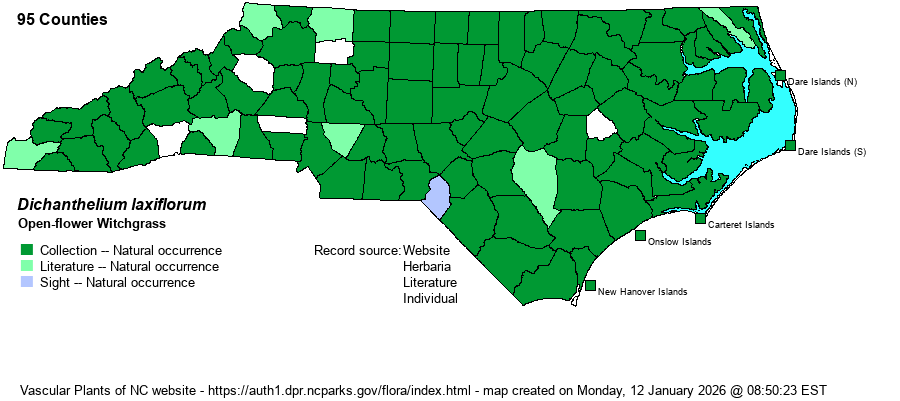| Author | (Lamarck) Gould | |
| Distribution | Throughout the state, doubtless found in every county.
MD to MO, south to southern FL and southeastern TX; W.I., Mex., C.A. | |
| Abundance | Common to abundant. | |
| Habitat | Its original, natural habitat is probably bottomland hardwoods, but has expanded with disturbance to occupy other moist to dry forests and woodlands, openings, roadsides, yards, suburban and urban lots. | |
| Phenology | Flowering and fruiting April-September. | |
| Identification | The basal rosette is not well-defined and the stems and leaves are crowded basally, thus giving this species a bunched look. Flowering stems reportedly may reach 1.5 feet high or long, but the great majority of plants are 10 inches or less high/long. Its color is a bright, chartreuse green and this alone attracts attention vs. other Dichs, which tend to be a darker/cooler green color. | |
| Taxonomic Comments | None, other than named as Panicum laxiflorum in older references.
A note about Dichanthelium: This genus is not impossible to identify to species! But it takes applied effort over a period of time in order to learn the various species and what their morphological limits are. We strongly recommend that you read the introduction to the treatment in Weakley et al. (2023), written by Richard LeBlond. LeBlond has made order out of near chaos, and his keys work very well for our plants. Most Dichanthelium taxa ("Dichs") do not grow everywhere indiscrimminately, but prefer certain well-defined habitats. Note that most species produce flowers/fruits twice a year -- a vernal period and an autumnal period -- and that measurements of spikelets and achenes are taken from vernal plants. Some species also have a third, or summer, period. In the vernal period there is a single inflorescence at the tip of the stem. In the autumnal period, plants produce elongate branches with bunched (congested) leaves and so look quite different from vernal plants. Inflorescences are produced in leaf axils as well as at the tips of branches. NOTE: Older texts had these species essentially all within the very large genus Panicum. "Dich" species are typically named as "Witchgrass" and Panicum species named as "Panicgrass". | |
| Other Common Name(s) | Open-flower Rosette-grass | |
| State Rank | S5 | |
| Global Rank | G5 | |
| State Status | | |
| US Status | | |
| USACE-agcp | FAC link |
| USACE-emp | FACU link |

